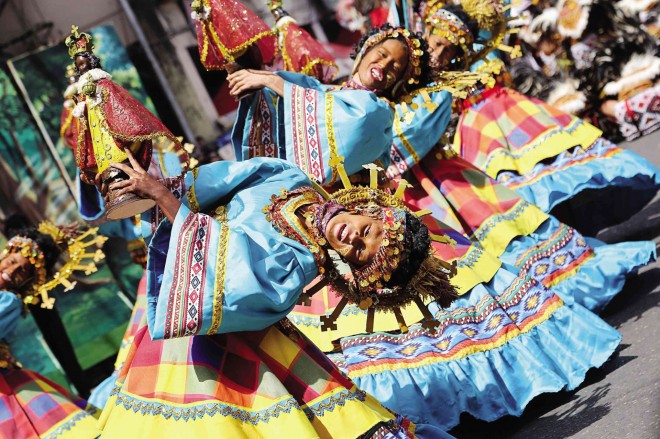Dinagyang Festival goes multiregional

ILOILO’S Dinagyang Festival has evolved into a showcase of multiregional festivals and culture. Photo courtesy of Iloilo Dinagyang Foundation Inc.
ILOILO CITY—This year’s Dinagyang Festival, a culmination of weeklong festivities in celebration of the feast of the Holy Child Jesus, is evolving into a showcase of multiregional and national culture.
For one, the Kasadyahan cultural festival Saturday, a day before the Ati tribe contest that has been the centerpiece of the festival held every fourth Sunday of January, has grown into an exhibition across provinces in Western Visayas instead of being simply participated in by groups based in Iloilo City.
On Sunday, the Hinugyaw Cultural Troupe of Koronadal City in South Cotabato province, and the Talakudong Festival of Tacurong City in Sultan Kudarat province will join the Ati tribe dance contest as guest performers.
It would be the first time that Mindanao groups would take part in the festival, according to Benito Jimena, city tourism officer.
Iloilo City Mayor Jed Patrick Mabilog is expected to bestow the honorary “Dinagyang Pangulong Hangaway” title on Koronadal Mayor Peter Miguel and Tacurong Mayor Lina Montilla on Sunday.
Article continues after this advertisementNine Ati tribes will compete for the championship.
Article continues after this advertisementThese are: Tribu Paghidaet of La Paz National High School; Tribu Panayanon of Iloilo City National High School (defending champion); Tribu Obreros of Barrio Obrero National High School; Tribu Ilawudnon of Sto. Rosario Street; Tribu Baybayanon of Barangay Calaparan in Arevalo District; Tribu Salognon of Jaro National High School; Tribu Atub-Atub of Barangay Veterans Village; Tribu Ilonganon of Abanilla Street in Lapuz District, and Tribu Milagrosa of Passi City.
5 judging areas
The carousel-type performances along the main streets of the city will be held in front of five stages or judging areas located at the Iloilo Freedom Grandstand, Iloilo provincial capitol, Mabini and Delgado Streets, Quezon and Ledesma Streets, and the Iznart Street-Maria Clara area.
Organizers increased the number of judging areas from four to five to accommodate more spectators.
The judging areas can seat only 7,000 spectators, but a million tourists and revelers are expected to watch the performances along the streets on Saturday and Sunday, according to Jimena. Among the guests are Ambassadors Philip Goldberg (United States), Thomas Ossowski (Germany), Ivo Sieber (Switzerland) and Esra Cankorur (Turkey).
Jimena said the city’s 2,500 hotel rooms had been booked months before, with other guests being accommodated in hotels and resorts outside of the city.
Longer time
The tribes will perform longer as organizers extended the time from five to seven minutes. They are given two minutes for entrance and exit numbers.
Choreographers would have more time to design the story line or show concept under the theme “Señor Sto. Niño, Hope of the Poor,” Jimena said. “We can expect more cohesive and clearer interpretations of concepts and story lines,” he said.
The Kasadyahan competition will be joined by 10 groups from Western Visayas: the Salakayan Festival (Miagao, Iloilo), Sigabong sang mga Kanyon (Bago City, Negros Occidental), Tribu Tatusan (Caluya, Antique), Tribu Kaing (Leon, Iloilo), Padagyaw (Dumarao, Capiz), Hubon Balsahan sa Manggahan (Sibunag, Guimaras), Pintaflores (San Carlos City, Negros Occidental), Tribu Suludnon/Patabang Festival (Tapaz, Capiz), Pantat Festival (Zarraga, Iloilo), and MassKara Festival (Bacolod City).
The Iloilo Dinagyang Foundation Inc. has increased subsidies to competing groups in the Ati tribe contest as part of efforts to widen participation and improve performances—from P320,000 to P400,000 for each tribe and from 150,000 to P200,000 each for the Kasadyahan.
The festival is rooted to the bringing of a replica of the image of the Child Jesus, Señor Sto. Niño de Cebu, to Iloilo City in 1968 by a delegation of the Cofradia de Cebu and Fr. Sulpicio Enderes, OSA.